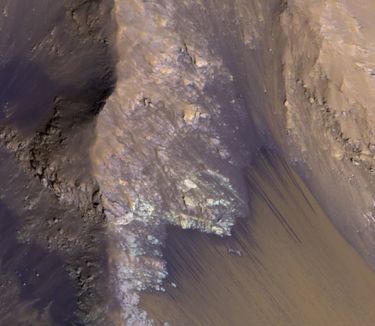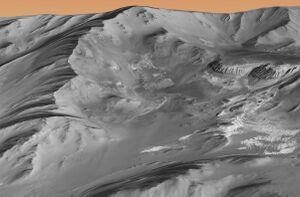Coprates Chasma Slope
The exploration of this location has not yet been documented All information is unverified estimation | ||||
|---|---|---|---|---|
| Rating: | ||||
| | Difficulty:4A VI XX (v7a1 VI) Raps:
Red Tape:Permit required Shuttle:Required 4400 miles Vehicle:4WD - Very High Clearance | |||
| Location: | ||||
| Condition Reports: | ||||
| Best season: | ||||
| Regions: | ||||
Introduction[edit]
Coprates Chasma is a large canyon within Valles Marineris, the Grand Canyon of Mars. This trip describes the descent of a particular north-facing slope on the edge of Coprates Chasma.
While water is abundant near the poles of Mars, survival in these regions would be extremely difficult. The presence of water near the equator has been a significant discovery in the effort toward a manned mission to Mars. While this slope is unlikely to have any particularly interesting technical features (as the flow lines are very straight), its historical significance may warrant a visit.
Note that the coordinates given are on Mars, not on Earth, and therefore the map displayed on this page is not accurate. To view these coordinates on Mars, open Google Earth, click on the planet icon in the set of buttons above the map, and select Mars. Then, type the coordinates into the search box and click Search.
Approach[edit]
The logistics of this canyon are somewhat more challenging than typical and break down into three major parts.
Reaching Mars[edit]
The challenge of simply reaching Mars is substantial and will require another vehicle in addition to your high-clearance 4WD rover. Multiple propulsion methods have been proposed, but the ones considered most likely to succeed currently are traditional chemical propulsion and nuclear thermal, which superheats a gas before expelling it to generate thrust. Photonic rockets are generally considered infeasible due to their slow acceleration. With an appropriate vehicle, the trip from Earth should take around 180 days. Make sure to bring an appropriate thruster system to decelerate safely to the surface once reaching Mars.
Life support[edit]
The environment on Mars is very challenging; it has only 1% the atmospheric pressure of Earth, and temperatures drop to -190F. Even a dry suit is probably insufficient for such an environment; it is likely you will need to bring and wear a suit that provides all of its own life support capability.
Shuttle[edit]
The ridge above this slope is located at roughly 15,700 feet while the canyon floor is at roughly -14,400 feet. Doing this canyon as a loop would thus likely be somewhat difficult and a shuttle is recommended. Unfortunately, the shuttle route would likely be very long and routes have not yet been verified. There are two main approach possibilities: east toward Aurorae Sinus, or west toward Melas Chasma. Melas Chasma offers the possibility of climbing the ridge starting at a weakness around -12.06, -68.96 on grades less than 50%. However, there is no flat ridge top at this point and you will need to route-find along 155+ miles of knife-edge ridge tops to reach the drop in point. Aurorae Sinus offers what is likely a more flat drive along the ridge top, but it is much longer at around 1200 miles total. From the valley floor where you leave a recovery vehicle, head east for about 550 miles and then hug the ridge on your right as you make a 180 at -15.4, -49.6 and head up the crater to the lip of the plateau. Follow the edge of the canyon to -15.4, -58.3 where you must cross the small 6-mile-wide, 2000-ft-deep canyon before proceeding to the drop in point at -13.174, -64.590.
Descent[edit]
Topographic maps for this area do not have high resolution, which makes an accurate prediction of the technical obstacles impossible. To be safe, you could bring 30,000 ft of rope to be assured you could fix ropes at each drop. But, this is probably more conservative than necessary and 5,000 ft is very likely to suffice. It is also possible that this descent is entirely class 2.
Exit[edit]
Once you reach your recovery vehicle, transfer the fuel that your generator has been creating from the martian resources (it is unlikely you will be able to carry enough fuel to return with you on the way to Mars) into it and prepare to leave the surface. Before ignition, make sure to double check that you have not forgotten to pack anything you want to bring with you; in addition to being very difficult to retrieve later, certain kinds of trash (contamination) are prohibited by international law. After leaving the surface, begin your trip back to Earth.
Red tape[edit]
The 1979 Agreement Governing the Activities of States on the Moon and Other Celestial Bodies establishes a number of restrictions governing conduct on Mars or any other celestial body. You must notify the Secretary General of the United Nations of your trip, and you must act on the behalf of a State which is a party to the agreement. Leave No Trace is required, as you may not alter the environment; this includes taking steps to prevent contamination. If you take home any souvenirs, they must be shared with all treaty countries and scientific organizations for research purposes. More details available here.
Beta sites[edit]
Trip reports and media[edit]
This trip report is for a different trip in the region, but may provide valuable insight for this trip.
MurrayLab Mars JPL/ESRI viewer An excellent viewer for Mars imagery produced the image below. (Note: Coordinate order is backwards from Google Earth)
Background[edit]
Scott Swaney claims to have descended this canyon, but the verified beta is currently unavailable.
Mars; You need to worry about earth.

